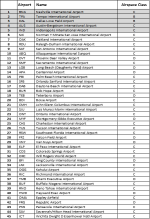TangoBearFox
Trusted Contributor
- Messages
- 164
Some of my favorite takeaways from reading the report:NTSB released their final report on the incident:
https://www.ntsb.gov/investigations/AccidentReports/Reports/AIR2402.pdf
The NTSB issued Safety Recommendation in July 6 2000, to install ASDE-X at most airports.
The FAA has said over many years they will not because it's too expensive. A quick google says there are currently 35 ASDE airports at a cost of 550 million to install. (15 million per system). Doesn't seem that much considering massive loss of life and property is the alternative.
The controller messed up, everyone knows that by now, everything in the report points to the controller messing up basic rules, expectation bias. He didn't fix it when it clearly wasn't going to work. He said he thought at the time it would have been more dangerous to send the FedEx around inside of 2 miles so they wouldnt climb into each other.
The SWA plane also did a 20 second run up on the RWY which didnt help either. The report talked about the controller's CPAP alot but said it wasn't a factor. Also, he recertified Local in February 2024 (congrats man).
The report talked about SMGCS alot but then came to the conclusion that it wouldn't have prevented the incident from occurring.
According to their SMGCS plan they have to use the same runway 18L for arrivals and departures when RVR for 18R falls below 1600 ft. Idk, how using the same runway during low visibility operations is safer and why the airport can't plan on upgrading lighting to prevent this but that seems like a reasonable solution to me and we can't have that.
FDX pilots are the heroes of this incident along with TCAS. SWA pilots in this incident should have done better between calling ready when they no where near the hold short and not communicating that they need time on the runway for an ENGINE RUN UP, but they also used TCAS to adjust their rate of climb to not die so that was good.
TLDR:
Controller very bad.
FDX pilots very good.
SWA pilots could have been better.

